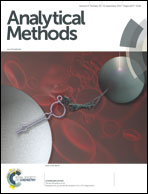A colorimetric assay for Hg2+ detection based on Hg2+-induced hybridization chain reactions
Abstract
A simple colorimetric sensing method for the detection of Hg2+ was developed by combining enzymatic catalysis with DNA-based hybridization chain reactions (HCRs). Firstly, thymine (T)-rich capture DNA (cDNA) was immobilized on a gold electrode via Au–S bonding. In the presence of Hg2+, thymine (T)-rich probe DNA (pDNA) hybridized with cDNA via T–Hg2+–T base pairs. Then the HCRs were realized using pDNA as an initiator and two biotin-labeled hairpin DNAs (H1 and H2) as fuel strands. Finally, numerous avidin-labeled horseradish peroxidase (HRP) enzymes were immobilized on long nicked ds-DNA strands, which can catalyze the H2O2-mediated oxidation of 3,3,5,5-tetramethylbenzidine dihydrochloride hydrate (TMB) to cause a dramatic color change. Under optimal conditions, the absorbance of TMB was linear with the logarithm of Hg2+ concentrations in the range of 1 fM to 1 pM, with a detection limit of 0.33 fM. This strategy exhibited good selectivity and high sensitivity, which might be a potential tool for the practical detection of Hg2+ in environmental monitoring.



 Please wait while we load your content...
Please wait while we load your content...